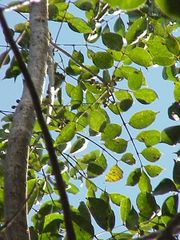Bursera
| Bursera subsp. var. | ||||||||||||||||||||||||||||||||||||||||||||||||||||||||
|---|---|---|---|---|---|---|---|---|---|---|---|---|---|---|---|---|---|---|---|---|---|---|---|---|---|---|---|---|---|---|---|---|---|---|---|---|---|---|---|---|---|---|---|---|---|---|---|---|---|---|---|---|---|---|---|---|

|
|
| ||||||||||||||||||||||||||||||||||||||||||||||||||||||
| ||||||||||||||||||||||||||||||||||||||||||||||||||||||||
Bursera, named after the Danish botanist Joachim Burser (1583-1639) is a genus with about 100 described species[1] of flowering shrubs and trees varying in size upwards to 25 m. high. They are native (often for many species endemic) to the Americas, from the southern United States south through to northern Argentina, in tropical and warm temperate forests habitats.
A number of species from tropical Asia were once included in this genus, but are now treated in the genus Protium
| Standard Cyclopedia of Horticulture |
|---|
|
Bursera (Joachim Burser, a disciple of Caspar Bauhin). Burserficeae. Usually tall trees, with simple or pinnately compound Lvs.: fls. small, in clusters, 4-5-parted, with twice as many stamens as petals or sepals, and a 3-parted ovary containing 6 ovules: fr. a 3-parted drupe with usually only 1 seed.—About 40 species of trees in Trop. Amer. For B. serrata, see Protium.
|
Cultivation
Propagation
Pests and diseases
Species
- Bursera aloexylon (Schiede ex Schltdl.) Engl.
- Bursera arida
- Bursera aptera
- Bursera arborea
- Bursera atenuata
- Bursera aspleniifolia
- Bursera bicolor
- Bursera biflora
- Bursera bipinnata
- Bursera bolivarii
- Bursera bonetti
- Bursera cerasifolia
- Bursera chemapodicta
- Bursera cinera
- Bursera citronella
- Bursera compacta
- Bursera copallifera
- Bursera coyucensis
- Bursera crenata
- Bursera cuneata
- Bursera delpechiana Poiss. ex Engl.
- Bursera denticulata
- Bursera discolor
- Bursera diversifolia
- Bursera epinnata
- Bursera excelsa (Kunth) Engl.
- Bursera fagaroides (Kunth) Engl.
- Bursera fagaroides elong.
- Bursera filicifolia
- Bursera fragantissima
- Bursera fragilis
- Bursera galeottiana Engl.
- Bursera glabrifolia (Kunth) Engl.
- Bursera grandifolia
- Bursera graveolens (Kunth) Triana & Planch.
- Bursera heteresthes
- Bursera hindsiana
- Bursera hintonii
- Bursera infiernidialis
- Bursera instabilis
- Bursera isthmica
- Bursera heliae
- Bursera kerberii
- Bursera krusei
- Bursera lancifolia
- Bursera laurihuertae
- Bursera laxiflora
- Bursera leptophloeos Engl.
- Bursera longpipes
- Bursera macvaughiana
- Bursera malacophylla B.L.Rob.
- Bursera medranoana
- Bursera microphylla A.Gray
- Bursera mirandae
- Bursera morelensis
- Bursera multifolia
- Bursera multijuga
- Bursera nesopola
- Bursera odorata
- Bursera occulta
- Bursera palaciosii
- Bursera palmeri
- Bursera penicillata (DC.) Engl.
- Bursera ribana
- Bursera rzedowski
- Bursera ruticola
- Bursera sarcopoda
- Bursera sarukhanii
- Bursera schlechtendalii Engl.
- Bursera simaruba (L.) Sarg.
- Bursera staphyleoides
- Bursera stenophylla
- Bursera submoniliformis
- Bursera suntui
- Bursera tecomaca
- Bursera tomentosa
- Bursera tonkinensis Guillaum.
- Bursera trifoliolata
- Bursera trimera
- Bursera vasquezyanesii
- Bursera vejar-vazquezii
- Bursera velutina
- Bursera xochipalensis
Gallery
-
photo 1
-
photo 2
-
Bursera penicillata trunks
-
Bursera penicillata fruits & leaves
-
Bursera penicillata trunk
References
- ↑ Becerra, Judith X.; D. Lawrence Venable (2008). "Sources and Sinks of Diversification and Conservation Priorities for the Mexican Tropical Dry Forest". PLoS ONE 3 (10): e3436. doi:10.1371/journal.pone.0003436. http://www.plosone.org/article/info%3Adoi%2F10.1371%2Fjournal.pone.0003436.
- Standard Cyclopedia of Horticulture, by L. H. Bailey, MacMillan Co., 1963
External links
- w:Bursera. Some of the material on this page may be from Wikipedia, under the Creative Commons license.
- Bursera QR Code (Size 50, 100, 200, 500)



